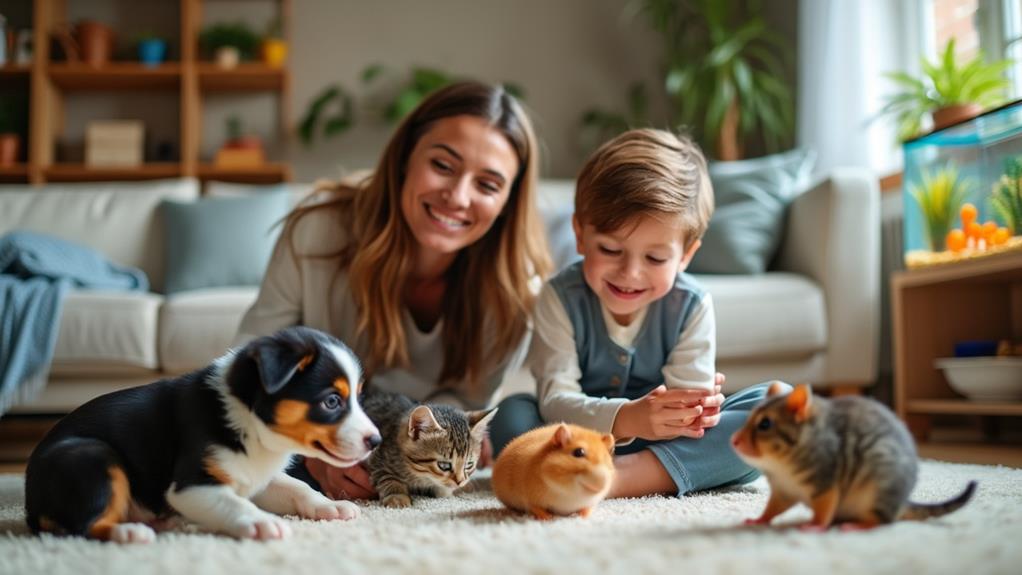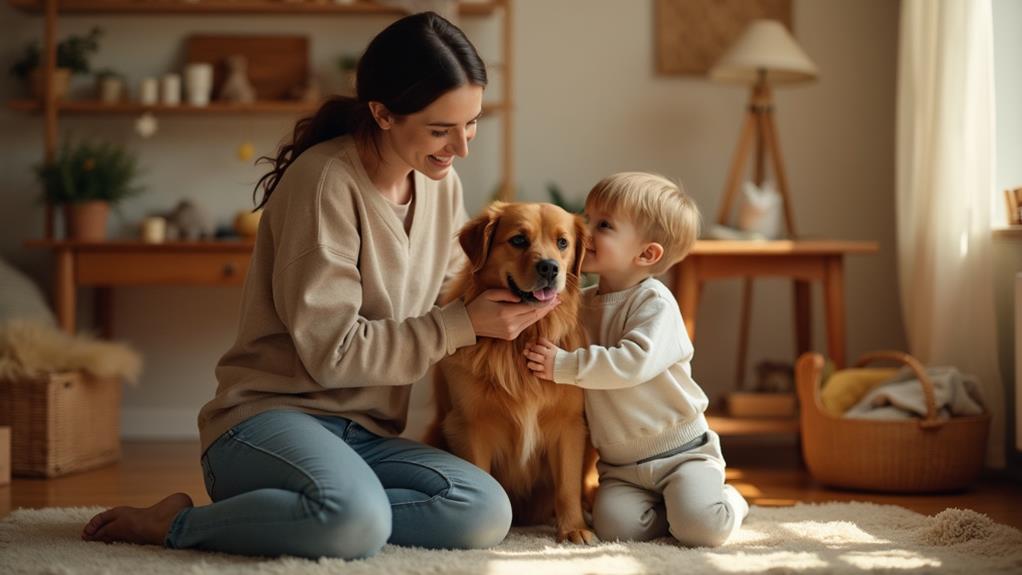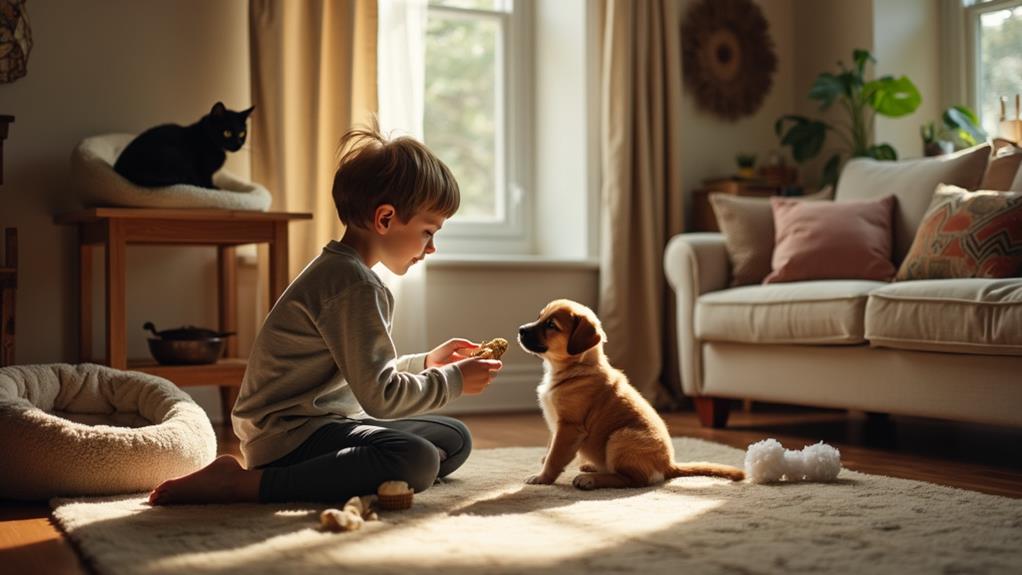A Parent’s Guide to Helping Kids Become Responsible Pet Owners

Introducing a pet into your household is more than just adding a new furry friend; it's an opportunity for your child to develop essential life skills. Pets can enhance social interactions, foster emotional growth, and teach responsibility. But how can you ensure your child becomes a responsible pet owner? It begins with careful preparation and continues through daily routines and proper training. Let's explore how each step, from choosing the right pet to utilizing community resources, can significantly impact your child's development and the well-being of your new family member.
Benefits of Pets for Children

Have you ever wondered how pets can positively impact a child's development? Having a pet around can significantly benefit your kids. Studies show that children exposed to pets early on develop stronger immune systems, making them less prone to sickness. This translates to fewer sick days and more active playtime.
But it's not just about physical health. When children engage in pet care tasks like feeding and cleaning, they learn responsibility and essential life skills. These activities foster compassion and respect for animals, qualities that will benefit them throughout life.
Socially, pets can be invaluable companions. Kids who interact with pets often display improved social skills, increased empathy, and heightened self-esteem. The simple act of caring for a pet helps children form emotional bonds that are crucial for their overall emotional development.
Moreover, the consistent companionship pets provide can make kids feel more secure and loved. This emotional support leads to healthier emotional and social growth. Overall, pet ownership offers numerous benefits for children, making them well-rounded individuals. So, if you're considering getting a pet, keep in mind that it's a fantastic way to contribute to your child's development.
Preparing for Pet Ownership
Preparing for pet ownership is an exciting yet crucial step in ensuring a harmonious relationship between your family and your future furry friend. Start by exposing your children to books and videos about pets to spark their interest and understanding of pet care responsibilities. This foundational knowledge helps children grasp what pet care entails.
Visiting local shelters as a family allows you to observe different kinds of animals, which can help children learn about pet care and preferences. This hands-on experience is invaluable in preparing for pet ownership. Discuss the long-term commitment involved, emphasizing daily responsibilities and the expected lifespan of various pets. This conversation helps children appreciate the dedication required.
Encourage your kids to ask questions and engage in conversations about animal care. This fosters curiosity and informed decision-making, essential for responsible pet ownership. Gradually introducing pets to new family dynamics, like playing sounds of babies crying, can help them acclimate to future changes.
| Activity | Purpose |
|---|---|
| Books and Videos | Spark interest and understanding |
| Shelter Visits | Learn about pet care and preferences |
| Discuss Commitment | Understand long-term responsibilities |
| Encourage Questions | Foster curiosity and informed decision-making |
| Gradual Introduction | Help pets acclimate to household dynamics |
Selecting the Right Pet

Selecting the right pet is a significant decision that influences the dynamics of your household. Start by considering your child's developmental stage and maturity level. Very young children (under 3-4 years) need constant supervision around pets, while older kids (over 7) can handle more responsibilities, teaching them about empathy and care.
Next, think about your living space. The size and energy level of the pet should match your home environment to ensure the well-being of both the pet and your family. For instance, a high-energy dog might not be suitable for a small apartment.
Involve your children in the decision-making process. Let them express their preferences and interests, fostering a sense of ownership and responsibility toward the pet. Assess any family allergies or sensitivities as some breeds are more allergy-friendly, ensuring a healthier environment for everyone.
Lastly, consider the lifespan and long-term care requirements of different pets. Whether you're considering dogs, cats, or smaller animals, understanding the commitment involved is crucial. This preparation helps children learn the importance of long-term responsibility and commitment.
Involving Kids in Pet Care
Involving kids in pet care is an excellent way to teach responsibility and empathy. Engaging them in daily pet care routines prepares them to become responsible pet owners. Start with tasks suitable for their developmental stage: toddlers can help by handing food to pets, while older children can manage tasks like brushing or exercising the animals. These responsibilities foster a sense of duty and help kids understand their pets' daily needs.
Consistency is crucial. Regular participation in pet care routines makes children more reliable and committed. When they see their efforts directly benefiting their pets, they learn the importance of caring for another living being. Praise their hard work, as positive reinforcement enhances their self-esteem and strengthens their bond with their pets.
Set clear expectations and consequences. Ensure children understand what is expected of them and the implications if they do not meet these responsibilities. This helps them grasp accountability and the real-world responsibilities of pet care. Involving kids in pet care not only helps them become responsible pet owners but also deepens their connection and empathy toward animals.
Teaching Proper Pet Interaction

Teaching children how to interact properly with pets is essential for fostering safe and harmonious relationships. Start by helping your child recognize when a pet is calm and relaxed. For dogs, teach them to look for signs like a loose mouth and a relaxed posture. Understanding these indicators is crucial for children to avoid agitating the animal.
Different pets have unique preferences for touch. For instance, cats generally enjoy being petted on their scent glands, such as their ears, chin, and cheeks, rather than on the head. Explaining these preferences to your child will promote better pet care.
Encourage your child to approach pets slowly and with gentle hands. This prevents startling the pet and fosters positive interactions. Using baby gates can effectively manage interactions between young children and pets, ensuring safety for both.
Observing and mimicking positive behaviors during pet interactions can further reinforce kind treatment and empathy. By modeling gentle and respectful behavior yourself, you provide a strong example for your child to follow. This hands-on approach to teaching kids about pet care will help them build lasting, compassionate relationships with their pets.
Ensuring Safety and Health
To ensure the health and safety of your family and pets, supervise interactions between children and pets to prevent accidents. Prioritize regular veterinary visits to identify health issues early and keep vaccinations current. Additionally, maintain a clean living environment and teach children proper hygiene around pets to minimize illness risks.
Supervised Interactions Always
Ensuring the safety and well-being of both children and pets begins with supervised interactions at all times. With over 4.5 million dog bites occurring annually in the U.S., and children being the most affected, constant supervision during interactions is crucial. Here's how to promote safe and positive engagements:
- Teach Calm Approaches: Encourage children to approach pets calmly and always ask for permission before interacting. This helps prevent aggressive behavior and fosters a safe environment.
- Set Boundaries: Establish clear boundaries for pet interaction, including a safe space for pets to retreat to if they feel overwhelmed or stressed. This reduces stress and promotes a harmonious relationship.
- Monitor Body Language: Pay attention to your pet's body language. Signs like a stiff body or a tucked tail indicate agitation. Intervene promptly to prevent potential incidents.
Additionally, educate children on safe handling practices. Teach them to avoid rough play and recognize when a pet does not want to be touched. This fosters respect and helps children build positive relationships with pets. Supervised interactions are essential for the well-being of both children and pets.
Regular Veterinary Care
Regular veterinary care is crucial for maintaining your pet's health and safety. Routine checkups help detect health issues early, with many pets needing annual visits for vaccinations, dental care, and preventive treatments. Involving your children in this process can teach them the importance of regular veterinary care.
Start by having your children track veterinary appointments on a calendar. This simple task fosters a sense of responsibility and keeps your pet's health needs at the forefront. Encourage them to research pet immunizations and health care routines, which educates them on the importance of preventive care and reinforces their role in their pet's well-being.
When it's time for a vet visit, take your children along. They can observe and learn firsthand about proper pet care and the importance of regular health assessments. Ensure that children do not hold pets during examinations to avoid stress for both the child and the animal, ensuring a more comfortable experience for everyone involved.
Hygiene and Cleanliness
Maintaining your pet's environment is essential for your family's health and safety, not just for appearances. Regular cleaning of pet areas like bedding and litter boxes prevents odors and minimizes allergens and parasites. Teaching your kids to help with these tasks instills responsibility and ensures a safer home.
Here's how to effectively manage pet hygiene:
- Bathing: Follow your veterinarian's recommendations for bathing your pets. This reduces dander and keeps the environment healthier, especially for children with allergies.
- Hand Washing: Always wash hands thoroughly after handling pets or cleaning their areas. This practice prevents the spread of bacteria and infections, safeguarding your family's health.
- Air Quality: Vacuum frequently and use an air purifier to improve air quality by reducing allergens and respiratory irritants.
Establishing a routine for these hygiene tasks helps your children learn responsibility while contributing to a clean and safe living environment. Prioritizing pet hygiene ensures both your pet's well-being and your family's health.
Training and Socializing Pets

Involving your children in the training and socialization of pets can be a rewarding experience for the entire family. Teaching basic obedience commands, such as "sit" and "stay," not only enhances your pet's behavior but also helps your child develop essential social skills. Through participation, children learn patience, communication, and responsibility, fostering a sense of accountability for their pet's behavior.
Positive reinforcement techniques, like using treats and praise, yield better results during training sessions. These methods strengthen the bond between your children and their pets, making the process enjoyable for everyone involved. Consistent routines help pets understand commands and build trust, making them more responsive to your children's guidance.
Equally important is socializing your pet with other animals and people. This practice improves your pet's comfort in various environments, reduces anxiety, and promotes positive interactions. Regular socialization teaches pets to be calm and friendly, reinforcing good behavior and enhancing their overall well-being.
Managing Daily Pet Responsibilities
Involving children in daily pet care is crucial for raising responsible pet owners. Assigning age-appropriate chores helps them develop a sense of responsibility and understand their pets' needs. Younger children can start with simple tasks like feeding or giving treats, while older kids can manage more complex duties such as walking dogs or cleaning cages.
Establishing a routine for pet care fosters reliability. A consistent routine emphasizes the importance of daily care. Here's a straightforward approach:
- Create a Task Chart: Use a chart or calendar to track daily pet care tasks. This promotes accountability and gives children a sense of accomplishment.
- Assign Age-Appropriate Chores: Younger children can handle feeding and giving treats, while older kids can take on walking the dog or grooming.
- Praise and Reinforce: Consistent praise and positive reinforcement motivate children to responsibly fulfill their pet care duties.
Engaging With Community Resources

Involving your children with community resources can enhance the pet ownership experience for the entire family. Visit local pet shelters to meet prospective pets and consult veterinarians for expert care advice. Utilize educational materials like books and videos to teach empathy and responsibility, making the learning process enjoyable and effective.
Leveraging Local Pet Shelters
Visiting local pet shelters as a family can be an enlightening experience, giving children a firsthand look at various pets and their care requirements. This exposure helps children understand the responsibilities involved in pet ownership. Interacting with shelter staff provides valuable insights into pet behavior and personality traits, aiding in the decision of which pet might best suit your home.
Beyond learning about pet care, many shelters offer educational programs and workshops that provide children with practical experience. These activities can deepen their understanding and commitment to responsible pet ownership. Here are three effective ways to utilize local pet shelters:
- Educational Programs: Enroll your children in workshops that focus on pet care and animal welfare.
- Volunteering: Encourage your children to volunteer at the shelter, fostering compassion and responsibility through hands-on animal care.
- Adoption Events: Attend adoption events to emphasize the importance of adopting pets rather than purchasing them.
Consulting Veterinary Experts
Local pet shelters provide valuable hands-on experiences, but consulting veterinary experts adds another layer of insight into responsible pet ownership. Veterinarians can help you understand different pet personality traits, ensuring your family chooses a pet that fits your lifestyle and expectations. This step is vital for long-term pet care and fostering a sense of responsibility in your children.
Many veterinary clinics offer educational resources and workshops tailored for families. These sessions cover essential topics like proper pet care, health maintenance, and behavioral guidance. By attending these workshops, you and your kids can learn how to keep your new pet happy and healthy.
Regular veterinary visits are another significant aspect. These appointments not only help monitor your pet's health but also provide an opportunity for your children to engage in discussions about pet care. This involvement fosters a deeper sense of responsibility and commitment.
Veterinary experts can also address specific behavioral concerns. Whether it's training or socializing your pet, their professional advice can guide your family in creating a harmonious home environment. By leveraging veterinary expertise, you're setting the foundation for responsible pet ownership and ensuring your pet thrives.
Engaging Educational Media
Engaging educational media provides a dynamic approach to teaching kids about responsible pet ownership. Through books and videos, you can make learning about pets both enjoyable and informative. Titles like "What Pet Should I Get?" and "Sparky!" introduce children to various pets and their care needs, aiding in informed decision-making.
To enhance their learning experience, consider the following activities:
- Visit Local Pet Shelters: Take your family to local shelters to see different pets up close. This allows children to discuss their preferences and understand the responsibilities involved in pet care.
- Engage with Community Resources: Connect with local veterinarians and pet training classes. These resources offer valuable insights into pet personality traits and care techniques, improving your child's understanding of animal needs.
- Participate in Pet Events: Involve your family in activities like volunteering at animal shelters or attending pet adoption events. These experiences help children grasp the importance of responsible pet ownership.
Involving kids in community discussions and testimonials about pet ownership reinforces the emotional and social benefits of having pets, fostering empathy and teaching the significance of being responsible pet owners.




